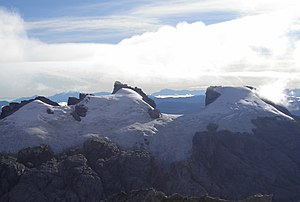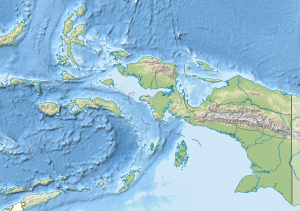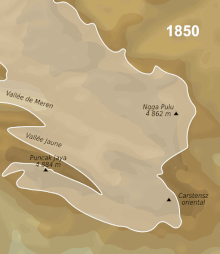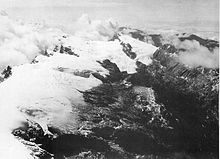Ngga Pulu
| Ngga Pulu | ||
|---|---|---|
|
View of the southern slope of Nga Pulu (snow cap on the right) and Sumantri (rocky peak in the middle) from the summit of Puncak Jaya (photo by Christian Stangl). |
||
| height | 4862 m | |
| location | Indonesia ( West New Guinea ) | |
| Mountains | Maoke Mountains ( Sudirman Range ) | |
| Dominance | 0.55 km → Sumantri | |
| Coordinates | 4 ° 3 '57 " S , 137 ° 11' 17" E | |
|
|
||
| First ascent | On December 5, 1936 by Anton Colijn , Jean-Jacques Dozy and Frits Wissel | |
The Ngga Pulu is a 4862 m high peak in the Sudirman Mountains in the Indonesian western part of the island of New Guinea ( Papua Province ).
In the past, some sources have listed the Ngga Pulu as the second highest mountain on the island of New Guinea after the Carstensz pyramid at 4884 m . He was therefore considered in mountaineering as one of five candidates for the status of the Second Summit on the continent of Oceania . According to recent research, the Ngga Pulu was the highest mountain in Oceania at the beginning of the 20th century because of its massive summit glacier. The melting of the ice cover has reduced the summit height considerably since its discovery. Today the Ngga Pulu is considered a secondary peak within the Carstensz region and the eight meters higher Sumantri is the second highest mountain in Oceania. (see section geography)
Surname
The name Ngga Pulu goes back to the native Papuan people. There are also other spellings such as Ngapalu or Ngga Poloe . The snow-covered high elevations of the Carstensz Mountains are also known as Dugundugu (or Ndugundugu ) by the Dani tribe , although this does not refer to a specific peak.
After the occupation of Western New Guinea by Indonesia in 1963, the Ngga Pulu was renamed Puncak Sukarno . This designation referred to Sukarno (1901-1970), the dictatorial president of Indonesia from 1945 to 1967. Today the name Puncak Sukarno is no longer common.
geography
location
Several of the highest peaks on the island of New Guinea are located in the Sudirman Range in the western Maoke Mountains . The Ngga Pulu is the easternmost peak in the Northwall Firn , a mountain range that runs from northwest to southeast and forms the northern boundary of a glacier valley (Meren Valley). Its southern boundary is represented by the almost parallel ridge of the Carstensz pyramid . The north wall drops very steeply to the northeast to the lower-lying tropical vegetation zones. The Ngga Pulu (4862 m) is a relatively flat summit covered by glacial ice, a few hundred meters to the northwest is the rocky summit of Sumantri (4870 m), the summits are separated by a glaciated saddle.
glacier
On the southern flanks of the Ngga Pulu massif there was an extensive contiguous glacier area at the beginning of the 20th century, which as a valley glacier extended far into the Meren Valley. In the first half of the 20th century, a clear decline in all glaciers in the high mountains of New Guinea was documented. In the Carstensz region, the extent was first made clear in 1962 by Heinrich Harrer's expedition. A decline of the Meren Valley Glacier by over 400 meters was documented for the period between 1936 and 1962. At the beginning of the 20th century, the Ngga Pulu had a massive summit glacier, the volume of which has also decreased significantly. Complete melting of all glaciers in the region is expected over the next few years.
Height and independence
During the first ascent in 1936, the geologist Jean-Jacques Dozy barometrically calculated a height of 5030 m at the summit of Ngga Pulu ; a later comparison with trigonometric measurements showed that it was actually 4907 m high at the time and thus towered over the 4884 m high Carstensz pyramid. Due to the melting of the summit glacier, the Ngga Pulu has clearly lost height, and at the time of Heinrich Harrer's Carstensz expedition (1962) was already lower than the unglaciated summit of the Carstensz pyramid.
From the end of the 20th century, the Ngga Pulu ( 4862 m ), the second highest peak in the Carstensz region, was also viewed by some mountaineering authors as the Second Summit of Oceania (see Seven Second Summits ). In this context, the question was discussed whether the Ngga Pulu should be considered an independent mountain or a secondary peak due to its relatively low topographical prominence . Later research showed that due to the advancing glacier melt , Sumantri ( 4870 m ) , which is also in the Northwall Firn , towers over the summit of Ngga Pulu. So it was no longer considered for the series of ascents of the Seven Second Summits .
Alpinism
The first ascent of Ngga Pulu was carried out by a Dutch expedition, on December 5, 1936, Anton Colijn, Jean Jacques Dozy and Frits Wissel reached the summit from the south. At that time the Ngga Pulu was, because of the massive glaciation, the highest mountain between the Himalayas in the west and the Andes in the east and the highest mountain in Oceania .
The second ascent of Ngga Pulu was achieved in 1962 by the Carstensz expedition organized by Heinrich Harrer. In addition to the first ascent of the Carstensz pyramid, Harrer, Albert Huizenga, Russel Kippax and Philip Temple also climbed the Ngga Pulu on February 11, 1962. In 1964, an Indonesian-Japanese expedition also reached the summit via the southern flank.
In 1972 the British mountaineer Dick Isherwood managed the first ascent of the north face of the Ngga Pulu single-handedly. He and his comrades Leo Murray and Jack Baines had previously climbed the summit via the southern flank. The ascent from the Meren Valley over the glaciated southern flank is the normal route to the Ngga Pulu today.
literature
- Jean-Jacques Dozy : From the highest peak to the deepest pit. Discovery and development of gold and copper ore deposits of Irian Jaya, Indonesia . In: Bulletin for Applied Geology . Vol. 7, No. 1 , July 2002, p. 67–80 ( article online ( memento of September 28, 2007 in the Internet Archive ) as PDF , approx. 1.4 MB [accessed on April 14, 2015]).
- Heinrich Harrer: I come from the Stone Age: Eternal ice in the jungle of the South Seas , Berlin; Frankfurt / M .; Vienna: Ullstein.
- Geoff Hope: The Equatorial Glaciers of New Guinea. Results of the 1971–1973 Australian Universities' Expeditions to Irian Jaya: survey, glaciology, meteorology, biology and palaeoenvironments. Rotterdam 1976 pdf 17 MB
- Richard J. Isherwood: The Dugundugoo , in The Alpine Journal 1973, pp. 188-194.
- Philip Temple: Snow over the rainforest. With Heinrich Harrer on the peaks of New Guinea. National Geographic 2003 ISBN 3-89405-204-X , ISBN 3-442-71194-0
Individual evidence
- ↑ Peakbagger.com - Ngga Pulu : "Isolation: 0.55 km / 0.34 mi Nearest Higher Neighbor in the PBC database: Sumantri (NNW)", accessed on March 2, 2015.
- ↑ cf. Heinrich Harrer (1963): Map of the Carstensz region , accessed on 7summits.com on April 2, 2015.
- ↑ Richard J. Isherwood (1973): The Dugundugoo , In Alpine Journal 1973, pp. 188f.
- ↑ Heinrich Harrer (1963): I come from the Stone Age: Eternal ice in the jungle of the South Seas , Berlin; Frankfurt / M .; Vienna: Ullstein, p. 31.
- ↑ Reinhold Messner (1989): The freedom to break up wherever I want , Piper, Munich, p. 131f.
- ↑ Richard J. Isherwood (1973): The Dugundugoo , In Alpine Journal 1973, pp. 189f.
- ↑ Summitpost.com - Sumantri , accessed March 13, 2015.
- ↑ Joachim Hoelzgen: The last South Sea glaciers are melting away. In: Spiegel Online . August 19, 2010, accessed March 28, 2011 .
- ↑ a b Jean-Jacques Dozy : From the highest peak to the deepest pit. Discovery and development of gold and copper ore deposits of Irian Jaya, Indonesia . In: Bulletin for Applied Geology . Vol. 7, No. 1 , July 2002, p. 67–80 ( article online ( memento of September 28, 2007 in the Internet Archive ) as PDF , approx. 1.4 MB [accessed on April 14, 2011]). From the highest peak to the deepest pit. Discovery and development of the gold and copper ore deposits of Irian Jaya, Indonesia ( Memento of the original from April 2, 2012 in the Internet Archive ) Info: The archive link was automatically inserted and has not yet been checked. Please check the original and archive link according to the instructions and then remove this notice.
- ↑ Heinrich Harrer: My life. Ullstein, Munich 2002, pp. 283ff.
- ↑ a b c Chris Myagar: Peakbagger.com - Ngga Pulu (English), accessed December 20, 2013
- ^ David Keaton (1997): Second Seven Summits , In: Rock & Ice No. 77, January / February 1997, Boulder (Colorado), pp. 56ff .; Retrieved from 8000ers.com on May 2, 2015.
- ↑ Geoff Birtles (2002): Second Best , In: High Mountain Magazine No. 240, Sheffield: 2002, pp. 4ff .; Retrieved from 8000ers.com on May 2, 2015.
- ↑ The topographical prominence (notch depth) of the Ngga Pulu was numbered differently, the information was between 200 and 373 meters. The website Peakbagger.com stated - contradicting itself - " 300 m / 100 ′ ", i.e. 300 meters (about 984 feet) or 100 feet (about 30 meters).
- ↑ The authors David Keaton ( Rock & Ice , 1997) and Geoff Birtles ( High Mountain Magazine , 2002) rated the Ngga Pulu as the second highest independent mountain in Oceania (see above).
- ↑ The alpine chronicler Eberhard Jurgalski considered the Ngga Pulu as a secondary peak based on a topographical prominence of around 200 m and an altitude of 4862 m. see. Eberhard Jurgalski (2012): Kammerlander / Stangl: "Seven Second" and "Third" Facts , accessed from 8000ers.com on May 2, 2015.
- ↑ The mountaineers Christian Stangl and Helmut Kritzinger considered the Ngga Pulu to be the second highest independent mountain in Oceania, in 2010 they referred to GPS and DGPS measurements by Kritzinger, which had shown a topographical prominence of 373 meters (see article: Helmut Kritzinger ).
- ↑ Christian Stangl: Sumantri - the second highest of Oceania ( Memento of the original from October 11, 2016 in the Internet Archive ) Info: The archive link was inserted automatically and has not yet been checked. Please check the original and archive link according to the instructions and then remove this notice. , accessed December 20, 2013
- ↑ Greg Slayden (peakbagger.com): Table of the five highest mountains on the continents , retrieved from skyrunning.at ( Memento of the original from October 11, 2016 in the Internet Archive ) Info: The archive link was inserted automatically and has not yet been checked. Please check the original and archive link according to the instructions and then remove this notice. on December 20, 2013
- ↑ Eberhard Jurgalski (8000ers.com): Table of the highest, second highest and third highest mountains on the continents , retrieved from skyrunning.at ( Memento of the original from October 11, 2016 in the Internet Archive ) Info: The archive link was inserted automatically and has not yet been checked. Please check the original and archive link according to the instructions and then remove this notice. on December 20, 2013
- ↑ NZZ.ch: Triple Seven Summits - A race for 21 summits , accessed on December 20, 2013.
- ↑ Heinrich Harrer (1963): I come from the Stone Age: Eternal ice in the jungle of the South Seas , Berlin; Frankfurt / M .; Vienna: Ullstein, p. 53f.
- ↑ Richard J. Isherwood (1973): The Dugundugoo , In Alpine Journal 1973, pp. 188f.
- ↑ Ibid. P. 193f.
See also
Web links
- Ngga Pulu and Sumantri on Summitpost.com (English)
- Ngga Pulu on Peakbagger.com (English)




